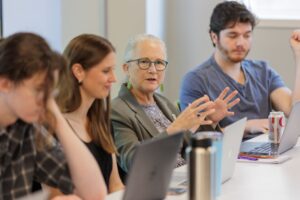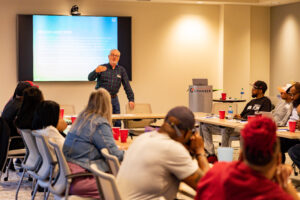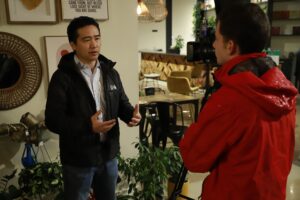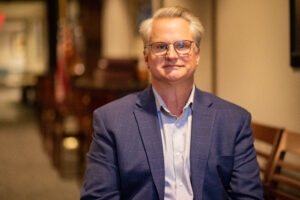Katrina Craven
If you could use the power of a massive computing network to improve care for stroke patients and reduce injuries for athletes, what would that process look like? At the University of Tennessee at Chattanooga the latest approach combines the power of computing analytics with real-time patient data.
It’s one thing to say that UTC provides innovative technologies that provide critical tools for students as they learn how to solve real-life problems – and it’s another to see this work in action – ‘real-time’ – as professors and students test techniques and methodologies.
When you listen to Professor Ashish Gupta talk about the myriad possibilities, you hear the enthusiasm that must be contagious with his students, both undergraduates and graduates. Gupta, Big Data and Analytics Research Center (BDARC) Director and Associate Professor of Analytics and Information Systems at the UTC College of Business, will tell you about some of problems he and his team can potentially solve.
In the examples of stroke patients and injured athletes, Gupta works with a team to provide healthcare professionals and trainers with real-time data to heal patients.
Collaborators include area healthcare and high tech organizations:
Erlanger Southeast Regional Stroke Center
Siskin Hospital for Physical Rehabilitation
Enterprise Center
CO.LAB
The secret weapon that makes this possible: the “GENI network,” short for Global Environment for Network Innovations, a tool that provides a backbone for a high-speed, distributed, virtual environment for development and research of next-generation technologies.
“Remote classrooms, distance labs and other projects that collaborate in real-time—all can benefit from the GENI network,” said Dr. Farah Kandah, Assistant Professor of Computer Science and Engineering in the UTC College of Engineering and Computer Science.
The GENI racks possess the ability to wall-off or isolate sensitive traffic. For example, the GENI network can be configured to run telemedicine applications by providing secure gigabit channels. In this instance, radiologists can remotely examine medical images in emergency cases during the middle of the night. Chattanooga will likely be one of the first cities in the country to demonstrate this application using the GENI rack.
In the example that Gupta gives about stroke patients, the technology rapidly integrates test results. Data sent over the GENI rack and network to a secured database can be processed in real time to help understand anomalies, analyze patterns, make predictions, develop visualizations and send recommendations on the fly to care providers, trainers, stroke patients and athletes.
“This is a significant step towards improving care and reducing injuries,” Gupta said. Rehabilitation is a key aspect of patient care following strokes, brain injury, or those who suffer from Parkinson’s disease.
Athletes may also benefit. The NCAA reported more than 250,000 sports injuries between 2004 and 2008 and experts predict increases.
“The system will be deployed in places where a medical director is not available and provide information on the state of an athlete’s health prior to the practice session or game,” Gupta said. “In addition, it can help athletes avoid repetitive injuries by providing real time assessments during practices or games.”
UTC partnered with The Enterprise Center and US Ignite to acquire the GENI rack. UTC’s GENI rack links with similar racks in other leading universities in smart cities in the U.S. and internationally. The racks act collectively as a programmable nervous system for researching and deploying the next generation of the Internet and cloud computing. UTC is the only non-research, tier-one campus in the country to house a GENI system.
This cutting-edge computing resource provides benefits to both campus researchers and EPB Fiber Optics network subscribers – a feature that makes the Chattanooga GENI rack unique. The arrangement enables area businesses the opportunity to develop, test and provide feedback on advanced next-generation Internet applications in education, healthcare and public safety.
As a catalyst for the national movement to create and deploy such applications, US Ignite has been working with Chattanooga and EPB since US Ignite’s formation, and the GENI rack and its connections will enable Chattanoogans to be among the first to experience them. Chattanooga’s 2015 GIGTANK accelerator will include an emphasis on leveraging this advanced infrastructure.
“We look forward to connecting other cities to Chattanooga and research universities via the GENI network so that new public-benefit applications can be developed collaboratively and shared for the benefit of many of the current set of US Ignite cities,” said William Wallace, executive director of US Ignite.
In Chattanooga, the Mozilla Gigabit Community Fund is developing gigabit-enabled applications. For example, Adagio, created by local musician Jonathan Susman, is a cloud-based audio remixing tool that will reach national and international audiences thanks to the GENI rack and its connections. Two entrepreneurial-minded UTC students created Viditor, a collaborative video-editing tool.
Other smart gigabit cities are developing applications in virtual reality – like immersing students in the Gettysburg battlefield or exploring the biological structure of living cells. More than 200 faculty members worldwide are engaged in this work and the GENI rack resource adds Chattanooga to this prestigious list.
“We expect this capability to accelerate our efforts to match UTC researchers with those at the best research universities in the country,” says Steve Angle, chancellor of UTC.
Launched with support from the National Science Foundation, GENI supports next-generation architectures for sharing advanced applications that require symmetric gigabit speeds, advanced local cloud computing (locavore computing) and/or software-defined networking.
“This GENI system brings a whole new level of research possibilities to our campus and our community,” said Tom Hoover, UTC associate vice chancellor and chief information officer. “Our faculty and students can conduct research in an environment that allows them to create next-generation computing and networking technologies.”
The Chattanooga GENI Rack hardware consists of a small “super” cluster of physical servers connected to a complex networking switch. This switch provides a high speed connection—10 Gbps—from UTC to other GENI racks hosted around the world, creating a geographically distributed computing environment.
The computing power of multiple GENI racks can also be harnessed to create a vast “meta” cluster that provides intensive “number crunching” capabilities. The high speed connectivity, combined with the distributed architecture, provides GENI with the flexibility and scalability to be the proving ground for technologies that will help create the next generation of Internet.
“This will allow UTC faculty and students to compete for far more grant dollars in the areas of technology and innovation—which again goes hand in hand with efforts in the city,” Hoover said
How does Ranger Rick use GENI rack?
Visiting the Tennessee Aquarium sounds like fun, but seeing 3D images of animals in their own environment hundreds of miles away from the Aquarium sounds like an old-school episode of Star Trek. This isn’t science fiction: Ranger Rick and his animals appeared real-time on TV screens in Chicago, in all their 3D glory.
Chicago students controlled their vantage point, looking up, down and around the animal Rick showed. Each student could view the same or different vantage points simultaneously. A special camera captured these 3D video images.
Sending a complete description of the scene 30 times per second required nearly a gigabit of bandwidth to the aquarium, the Chattanooga Public Library and our local STEM high school.
GENI RackEngage 3D and EPB used an early GENI network prototype to conduct this first city-to-city demonstration of student-controlled 3D television.








